Science
Researchers Discover Biochemical Pathway That Spurs Beige Fat Cells to Burn Energy

The discovery of a new signaling pathway in the brain is helping to unlock the biochemical mysteries between smoking and weight gain and loss. A research team, including bioanalytical neurochemist Alexander G. Zestos of American University, identified the pathway, which spurs beige fat cells to burn energy. That the pathway, already known to regulate nicotine dependence in the brain, also plays a role in metabolism raises new questions for researchers to explore.
“Until recently, we thought this pathway primarily existed in brain cells, and we didn’t know it was prevalent in certain fat cells,” Zestos said. “Is it the density of the brain receptors that a person has, or is it the way the receptors are activated, that contributes to one’s ability to gain or lose weight?”
The pathway, known as CHRNA2 (or cholinergic receptor nicotinic alpha 2), reveals a possible target for obesity therapies in humans. The team’s findings were published in Nature Medicine. Zestos collaborated with researchers from the University of Michigan’s Life Sciences Institute.
Zestos, who is a member of AU’s Center for Behavioral Neuroscience, joined AU at the start of the 2017-18 academic season. He received his Ph.D. in chemistry at the University of Virginia and completed his postdoctoral work at University of Michigan.
“I have been interested in chemistry for a long time because of its position at the intersection of science, primarily biology and physics. Studying chemistry helps us understand both physical phenomena and biological complexity,” he said. “Detection methods in chemistry will help us make the precise measurements needed to help make breakthroughs in neuroscience, metabolic studies, and other biomedical disciplines.”
For the beige fat research, Zestos and his colleagues conducted studies in mouse and human cells. Zestos developed methods that quickly detected 26 neurotransmitters, the chemicals in the brain that help pass messages along the pathway. Precise measurements are important in detection work, and Zestos monitored the neurotransmitters simultaneously and measured their concentration levels relative to one another.
Scientific understanding of beige fat cells is in its early stages. Many aspects of how the cells function are not yet known. It’s only recently that scientists found beige fat cells in human adults and noted their role in burning energy, resulting in improved metabolic health.
Beige fat cells help organisms defend against severe cold. As part of the immune response to cold, beige fat is synthesized by the brown fat mixing with small concentrations of white fat. The new research verifies the CHRNA2 signaling pathway is active when brown fat gets converted into energy to protect against cold. In mice, beige fat allows them to shiver to ward off cold. When the team deactivated CHRNA2 in mice, they weren’t able to protect against cold and they gained weight.
As part of the work, Zestos measured acetylcholine in the fat cells and verified it was inducing the pathway, and he came up with a way to extract the acetylcholine from fat cells.
The next step of the research will be to examine other neurotransmitters and their pathways for the roles they could play in activating beige fat cells, as well as to test the CHRNA2 pathway for possible therapies for weight loss and obesity prevention.
Additionally, Zestos is collaborating with AU faculty members in the departments of biology and psychology using the methods he’s developed to enhance the detection of neurotransmitters. For example, he’s collaborating with AU Associate Professor of Biology Vikki Connaughton’s research group using animal models to study diabetes of the eye; and with AU Psychology Professors David Kearns and Tony Riley on possible therapeutics for cocaine and amphetamine abuse.
